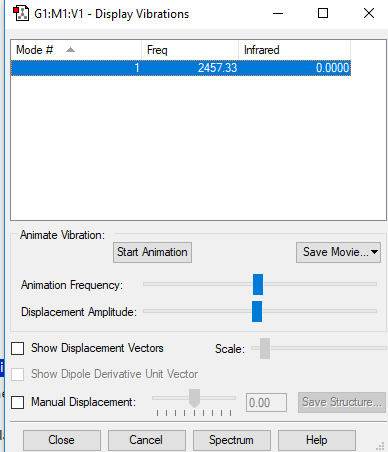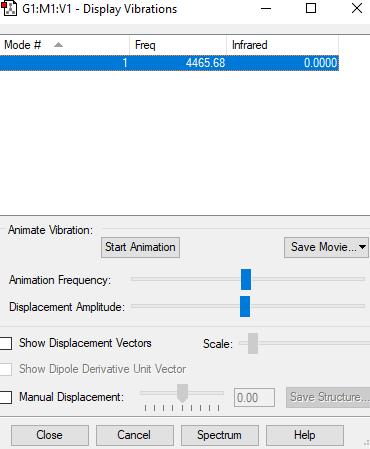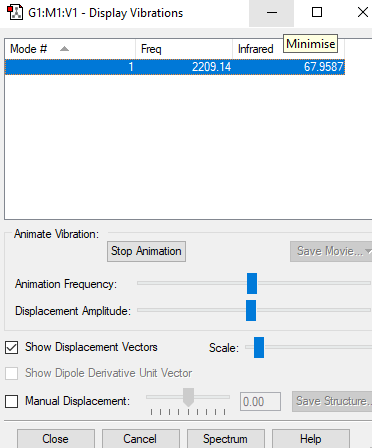Rep:Mod:XS2218
NH3 Molecule
Summary information
Molecular Name:NH3
Calculation Method:RB3LYP
Basis Set:6-31G(d,p)
Final Energy E(RB3LYP):-56.55776873 a.u.
RMS Gradient Norm:0.00000485 a.u.
Point group:C3V
Optimisation
Item Value Threshold Converged?
Maximum Force 0.000004 0.000450 YES
RMS Force 0.000004 0.000300 YES
Maximum Displacement 0.000072 0.001800 YES
RMS Displacement 0.000035 0.001200 YES
Predicted change in Energy=-5.986282D-10
Optimization completed.
-- Stationary point found.
optimised NH3 |
N-H Bond distance:1.02Å
H-N-H Bond angle:106°
The optimisation file is liked to here
Vibrations
Vibration Displays
Vibration Table
| wavenumber/cm-1 | 1090 | 1694 | 3462 | 3590 |
| Symmetry | A1 | E | A1 | E |
| Intensity/a.u. | 145 | 14 | 1 | 0 |
| Image | 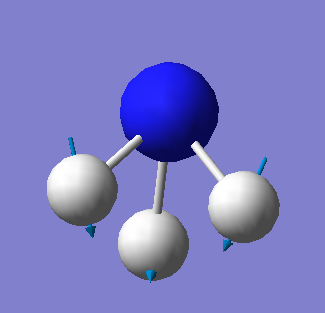
|
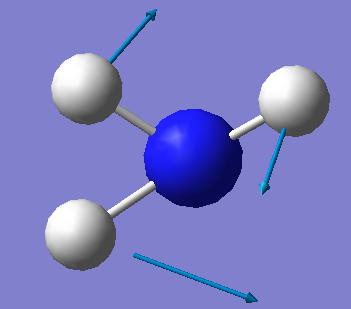
|

|
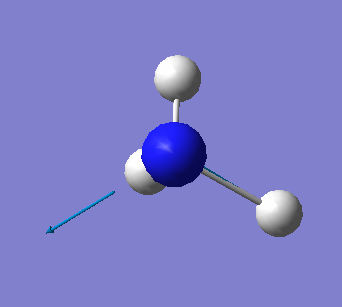
|
Questions
how many modes do you expect from the 3N-6 rule? 6
which modes are degenerate (ie have the same energy)? 2&3, 5&6
which modes are "bending" vibrations and which are "bond stretch" vibrations? bending:1,2,3 bond stretch;4,5,6
which mode is highly symmetric? 4
one mode is known as the "umbrella" mode, which one is this? 1
how many bands would you expect to see in an experimental spectrum of gaseous ammonia? 2
Atomic Charges
N:-1.123
H:0.375
We would expect N to be negatively charged as N is more electronegative, it draws electrons on H towards itself and H is expected to be positively charged.
N2 Molecule
Summary information
Molecular Name:N2
Calculation Method:RB3LYP
Basis Set:6-31G(d,p)
Final Energy E(RB3LYP):-109.52412868 a.u.
RMS Gradient Norm:0.00000060
Point group:D*H
Optimisation
Item Value Threshold Converged?
Maximum Force 0.000001 0.000450 YES
RMS Force 0.000001 0.000300 YES
Maximum Displacement 0.000000 0.001800 YES
RMS Displacement 0.000000 0.001200 YES
Predicted change in Energy=-3.400985D-13
Optimization completed.
-- Stationary point found.
optimised N2 |
N-N Bond distance:1.11Å
N-N Bond angle:180°
The optimisation file is liked to here
Vibrations
Vibration Displays
Vibration Table
| wavenumber/cm-1 | 2457 |
| Symmetry | SGG |
| Intensity/a.u. | 0 |
| Image | 
|
Atomic Charges
N1:0
N1:0
We would expect both N to be neutral as they have the same electronegativity.
H2 Molecule
Summary information
Molecular Name:H2
Calculation Method:RB3LYP
Basis Set:6-31G(d,p)
Final Energy E(RB3LYP):-1.17853936 a.u.
RMS Gradient Nomr:0.00000017 a.u.
Point group:D*H
Optimisation
Item Value Threshold Converged?
Maximum Force 0.000000 0.000450 YES
RMS Force 0.000000 0.000300 YES
Maximum Displacement 0.000000 0.001800 YES
RMS Displacement 0.000001 0.001200 YES
Predicted change in Energy=-1.164080D-13
Optimization completed.
-- Stationary point found.
optimised H2 |
N-N Bond distance:0.74 Å
N-N Bond angle:180°
The optimisation file is liked to here
Vibrations
Vibration Displays
Vibration Table
| wavenumber/cm-1 | 4466 |
| Symmetry | SGG |
| Intensity/a.u. | 0 |
| Image | 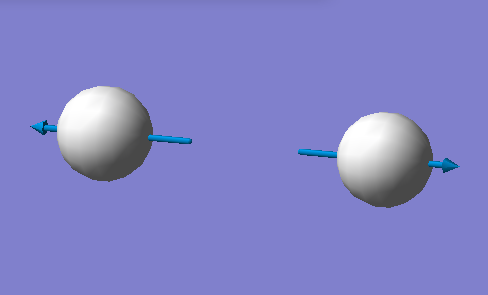
|
Atomic Charges
H1:0
h1:0
We would expect both h to be neutral as they have the same electronegativity.
Mono-metallic TM complex
Refcode: DOFBUX
Compound name:(1,3-bis((Di-t-butylphosphino)methyl)-2,3-dihydro-1H-1,3,2-benzodiazaborole)-dinitrogen-cobalt
Link:[1]
N-N bond distance:1.12 Å
The N-N bond distance in this crystal structure is different from the computational distance,it is slightly longer. This is because the computational distance is obtained from an optimised N2 structure which has the lowest energy, whereas in the crystal structure, the N-N is next to Co which is electropositive so it pushes the electrons to the N, electron-repulsion causes the bond to become longer.
Habor-Bosch Process
N2 + 3H2 -> 2NH3
E(NH3)=-56.5577687 a.u.
2*E(NH3)=-113.1155374 a.u.
E(N2)=-109.5241287 a.u.
E(H2)=-1.1785394 a.u.
3*E(H2)= -3.5356181 a.u.
ΔE=2*E(NH3)-[E(N2)+3*E(H2)]= -146.5 kJ/mol
The ammonia product is more stable than the gaseous reactants, this is an exothermic reaction
CO Molecule
Summary information
Molecular Name:CO
Calculation Method:RB3LYP
Basis Set:6-31G(d,p)
Final Energy E(RB3LYP):-113.30945314 a.u.
RMS Gradient Norm:0.00001828 a.u.
Point group:C*V
Optimisation
Item Value Threshold Converged?
Maximum Force 0.000032 0.000450 YES
RMS Force 0.000032 0.000300 YES
Maximum Displacement 0.000012 0.001800 YES
RMS Displacement 0.000018 0.001200 YES
Predicted change in Energy=-3.956716D-10
Optimization completed.
-- Stationary point found.
optimised CO |
CO Bond distance:1.14Å
CO Bond angle:180°
The optimisation file is liked to here
Vibrations
Vibration Displays
Vibration Table
| wavenumber/cm-1 | 2209 |
| Symmetry | SSG |
| Intensity/a.u. | 68 |
| Image | 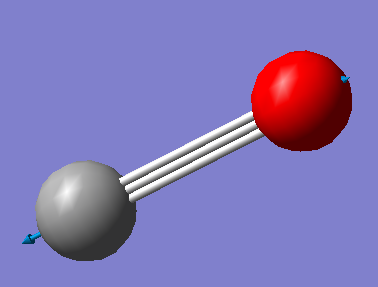
|
1 band is expected to see on the spectrum.
Atomic Charges
C:0.506
O:-0.506
We would expect O to be negatively charged as O is more electronegative, it draws electrons on C towards itself and so C is expected to be positively charged.
Molecular Orbitals
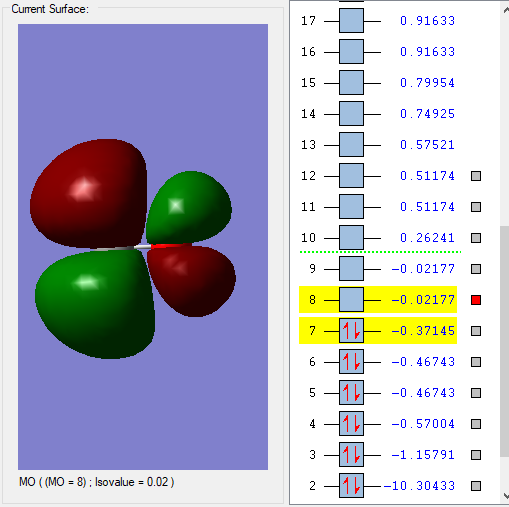 This is the LUMO, 1π* anti-bonding orbital. 2p AOs on C and O contribute to this MO.
This is the LUMO, 1π* anti-bonding orbital. 2p AOs on C and O contribute to this MO.
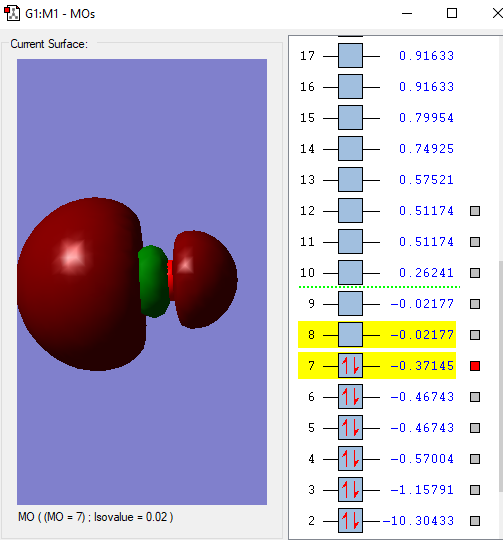 This is the HOMO. It is a mixture of 2s and 2p AOs and occupied by 2 electrons.
This is the HOMO. It is a mixture of 2s and 2p AOs and occupied by 2 electrons.
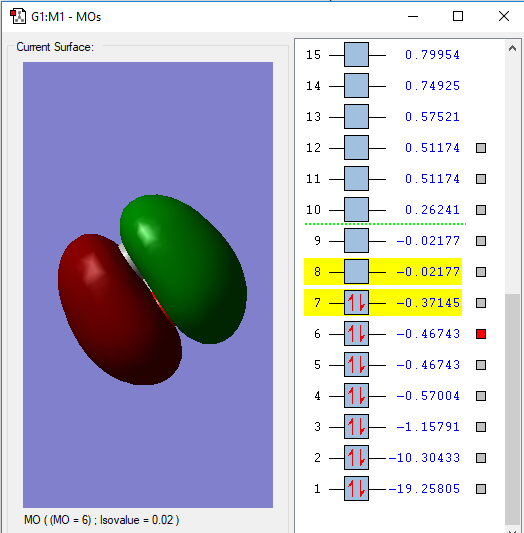 This is the 1π bonding orbital, 4 electrons from 2p orbitals on C and O contribute to this MO. It is slightly deeper in energy than HOMO.
This is the 1π bonding orbital, 4 electrons from 2p orbitals on C and O contribute to this MO. It is slightly deeper in energy than HOMO.
 This is the 4σ orbital. It is a mixture of 2s and 2p AOs and occupied by 2 electrons. It is also quite deep in energy.
This is the 4σ orbital. It is a mixture of 2s and 2p AOs and occupied by 2 electrons. It is also quite deep in energy.
 This is the 3σ bonding orbital. 2 electrons from 2s orbitals on C and O contribute to this MO. It is deep in energy.
This is the 3σ bonding orbital. 2 electrons from 2s orbitals on C and O contribute to this MO. It is deep in energy.
Marking
Note: All grades and comments are provisional and subject to change until your grades are officially returned via blackboard. Please do not contact anyone about anything to do with the marking of this lab until you have received your grade from blackboard.
Wiki structure and presentation 1/1
Is your wiki page clear and easy to follow, with consistent formatting?
YES
Do you effectively use tables, figures and subheadings to communicate your work?
YES
NH3 1/1
Have you completed the calculation and given a link to the file?
YES
Have you included summary and item tables in your wiki?
YES
Have you included a 3d jmol file or an image of the finished structure?
YES
Have you included the bond lengths and angles asked for?
YES
Have you included the “display vibrations” table?
YES
Have you added a table to your wiki listing the wavenumber and intensity of each vibration?
YES
Did you do the optional extra of adding images of the vibrations?
YES
Have you included answers to the questions about vibrations and charges in the lab script?
YES
N2 and H2 0/0.5
Have you completed the calculations and included all relevant information? (summary, item table, structural information, jmol image, vibrations and charges)
YES, However you have given a bond angle of 180 for N2 and H2, there are no bond angles in diatomic molecules. Bond angles involve exactly 3 atoms.
Crystal structure comparison 0.5/0.5
Have you included a link to a structure from the CCDC that includes a coordinated N2 or H2 molecule?
YES
Have you compared your optimised bond distance to the crystal structure bond distance?
YES
Haber-Bosch reaction energy calculation 1/1
Have you correctly calculated the energies asked for? ΔE=2*E(NH3)-[E(N2)+3*E(H2)]
YES
Have you reported your answers to the correct number of decimal places?
YES
Do your energies have the correct +/- sign?
YES
Have you answered the question, Identify which is more stable the gaseous reactants or the ammonia product?
YES
Your choice of small molecule 3/5
Have you completed the calculation and included all relevant information?
YES, you gave a bond angle which is invalid for a diatomic however.
Have you added information about MOs and charges on atoms?
YES, the information is present and you have done some correct analysis well done! To improve you could have written more detail in your MO explanations. For example explaining the impact of each MO on the overall bonding in the molecule, e.g. the LUMO has no effect even though it is antibonding because it is unoccupied.
Independence 0/1
If you have finished everything else and have spare time in the lab you could:
Check one of your results against the literature, or
Do an extra calculation on another small molecule, or
Do some deeper analysis on your results so far


